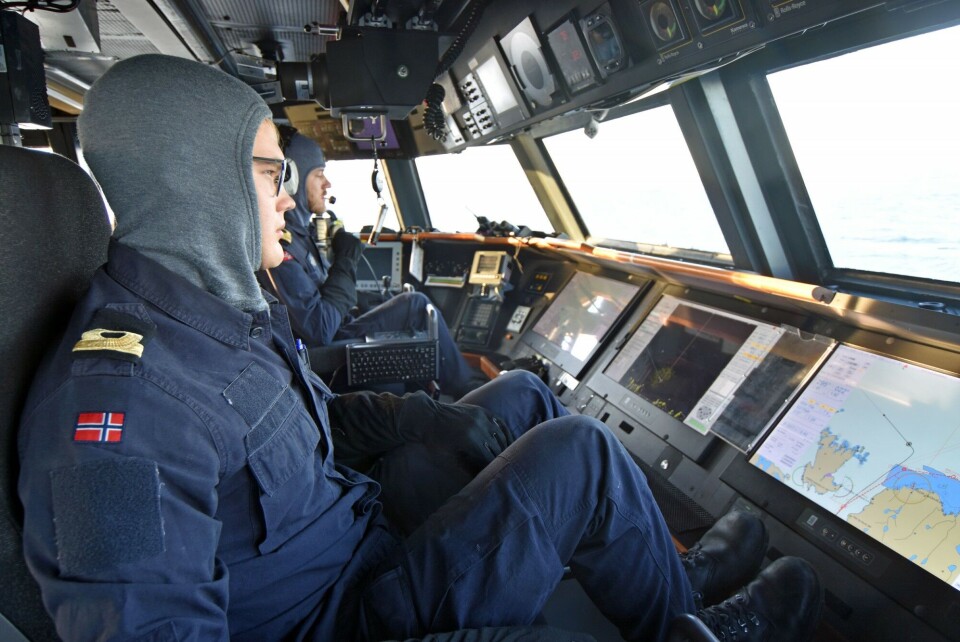
On patrol along its Arctic coast, Norway's relation with Russia is challenged between deterrence and reassurance
VARANGER FJORD - Top speed is classified but make no mistake, the KNM Gnist is the fastest and most maneuverable warship that ever has patrolled these border waters up north. For Norway, however, navigating its security policy as times get rough is becoming more and more difficult.
“There’s not many like us that can master conditions with icing, darkness, severe weather, strong winds,” says Captain Rune Sønstebø.
His crew makes ready for departure with the camouflage-colored catamaran. KNM Gnist is the newest of six fast patrol missile boats of the Skjold (‘shield’) class in the Norwegian Navy. It is small in size but carries a heavy weapon load.
Captain Sønstebø explains the ship’s covert operational capability in littoral warfare. “The coastal topography of northern Norway is unlike most other nations. The archipelagoes at Helgeland, as an example, we are unique in combating there.”
Seeing the Skjold class ships along the eastern coast of Finnmark region is nowadays not uncommon. From the Varanger fjord, Russia’s most powerful nuclear deterrence assets are just a few tens of nautical miles away. Protecting the ballistic missile submarines’ ability to launch in case of a global security threat is key to understanding why the Russian Northern Fleet has escalated its exercises off the coast of northern Norway in recent years.
With advanced weapons technologies, like the new long-range precision cruise missiles, modern multipurpose submarines and aircraft, Russia plans for denial operations in the maritime spaces of the North Atlantic. Maybe as far south as the North Sea. In case of conflict. Most of Norway falls within such a buffer.
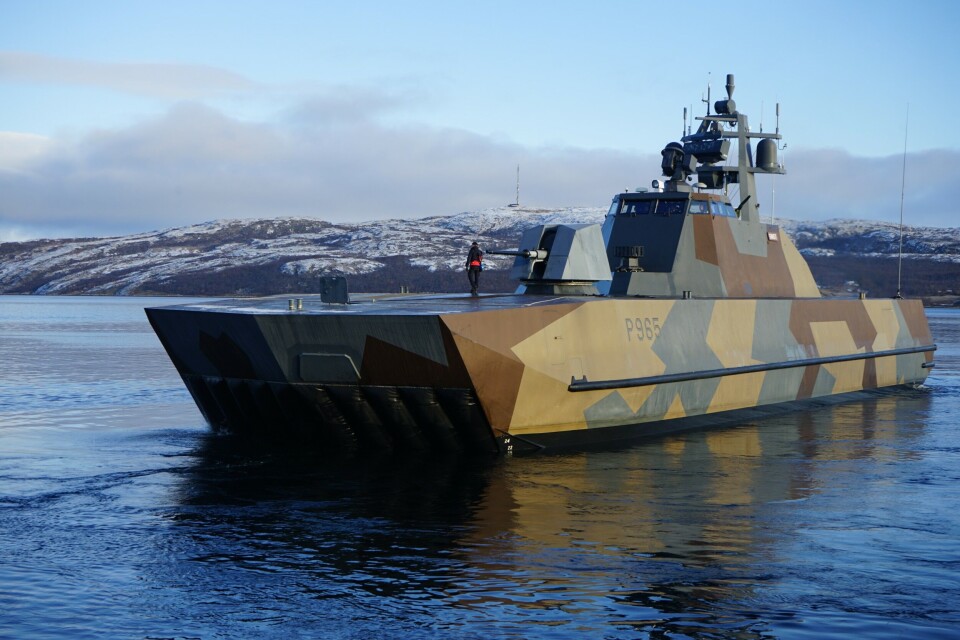
“We are sending a message by our presence at the Norwegian coast,” Rune Sønstebø says. He adds: “Finmark, like the rest of the Norwegian coast, is of utmost importance. To exercise, understanding the normalities and to show presence here are a part of the normal situation and an important area to know and master.”
Speaking with The Barents Observer about NATO’s elevated northern focus, Defence Minister Frank-Bakke-Jensen states: “Norway is NATO in the North.”
The minister is often traveling the faraway Arctic regions of the country. “We maintain situational awareness with continuous and credible presence.”
Bakke-Jensen is from Båtsfjord, a small fishing town on the coast to the Barents Sea where people and politicians for generations have maintained contact with their Russian neighbors in the east. Even during the years of the last Cold War. Keep going with cross-border cooperation benefiting both countries are high up on the agenda, not only for the locals but also for Oslo and Moscow. Fishery regulations, environmental protection, search- and rescue are some areas given priority also in times of geopolitical turbulence.
Norway’s Navy is not big, but few countries have crews better drilled on Arctic navigation. The two officers in the seats on the high-tech bridge on KNM Gnist give more power to the engines as we are sailing faster and faster out the fjord.
There are air cushion between the two hulls of the catamaran, literally lifting the ship on the water surface. Asked about the top speed, the crew members are unforthcoming. But smiles. Searching the internet you can find hints at above 60 knots.
Sønstebø translates the speed into a geographical understanding: “We can eat breakfast in Bergen and dinner in Tromsø.”
We can eat breakfast in Bergen and dinner in Tromsø.
The ship has a crew of 21. On the rear deck are two launchers armed with the NSM (Norwegian strike missile), which has a range of 185 kilometers, according to Wikipedia. On the front deck is the gun, firing shells to a range of 16 kilometers.

With unique maneuverability, the KNM Gnist can engage hostile forces from close distance anywhere along the coast. Reduced signatures, or stealth, makes the vessel less visible on enemy radar. The shallow draught allows for sailings in very shallow waters, utilizing it for own advance, where other navy ships can’t come.
On a day with clear skies, Russia’s Fishermen Peninsula is an easy eye-catcher from the Varanger fjord. The Peninsula forms a natural barrier from the west, protecting the Northern Fleet’s submarine bases of Zapadnaya Litsa, Vidyayevo, Gadzhiyevo, Olenya Guba, and Polyarny.
NATO steps up
Russia’s President, Vladimir Putin, and his commanders like Chief of Staff of the Armed forces Valery Gerasimov and Defence Minister Sergey Shoigu, have increasingly stressed the importance of the strategic nuclear forces. “I want to emphasize that, despite the constantly changing nature of military threats, the nuclear triad remains the primary, key guarantee of Russia’s military security,” Putin said in a November meeting with senior Defense Ministry officials.
With well-known rhetorics aimed at his domestic audience, Putin continued: “NATO is expanding its military presence in Europe close to the Russian border, and has failed to respond to our proposal to scale down military activity during the epidemic. Moreover, NATO countries’ air forces and navies have even stepped up their operations.”
Seen from up north, Putin is partly right when talking about NATO. 2020 became the year when the U.S. Navy sailed into the Barents Sea with surface warships for the first time since the mid-1980s. On several occasions. First together with the British navy. On a later voyage, also a Norwegian frigate joined.
Prior to Moscow’s annexation of Crimea in 2014, Norwegian frigates made several friendly port calls to Severomorsk, the main naval base of the Northern Fleet. The maneuver in September with KNM Thor Heyerdahl, however, was the first-time such warship sailed east of the Varanger fjord on a mission not in cooperation with the Russian Navy.
Bridge over troubled waters
A change of tactics by a country that previously has intended not to openly provoke the Russian bear. Or recognition of a dramatically changed security picture. Views are mixed.
“It is definitively not a good idea unless Norwegian authorities only want to keep a strong relationship with one of the powers, the United States,” says Lieutenant Colonel Tormod Heier when asked about Norway’s sailing with NATO ships east of Varanger. Heier is professor at the Norwegian Defense College. He argues that Norway can’t keep a relationship with only the United States, but is forced to seek good relations with Russia as well.
Norway can’t keep a relationship with only the United States, but is forces to seek good relations with Russia as well.
“This is due to Norway’s unique geopolitical position, only 40 to 120 kilometers from some of Russia’s most valuable nuclear forces. Norwegian authorities, therefore, need to balance between almost incompatible great power expectations: to be a good ally in the west while also being a good neighbor in the east,” professor Heier says.
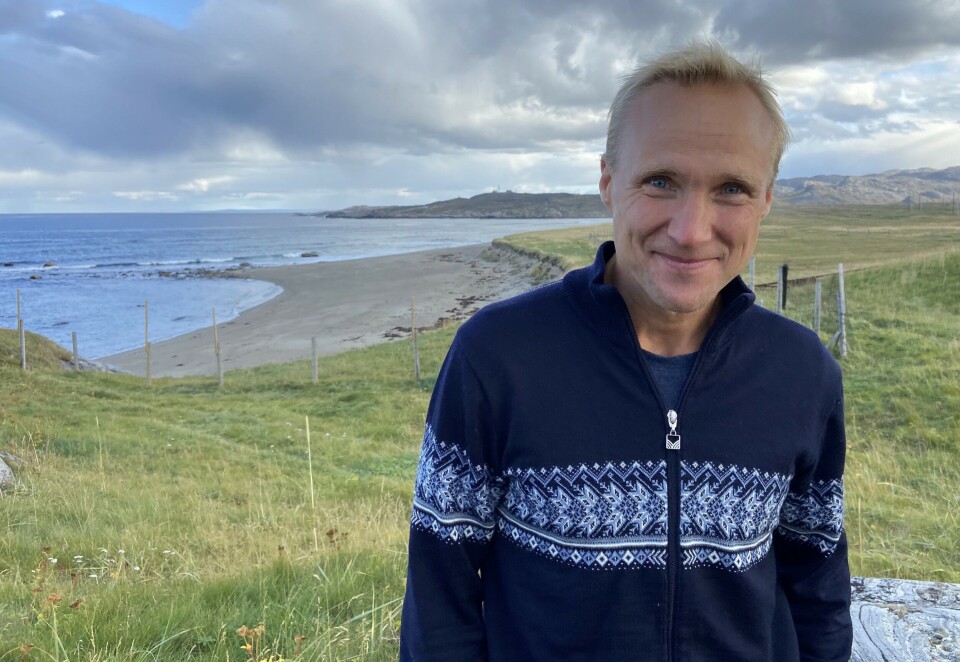
Moscow is well aware of Norway’s security policy of balancing between deterrence and reassurance.
Speaking friendship and geopolitics at a lunch hosted by Norway’s King Harald V in October 2019, the Russian Foreign Minister Sergey Lavrov praised the role of Norway as a peace negotiator around the world. “There is nothing that hinders Norway to take a lead in building bridge between Russia and NATO,” Lavrov said.
The lunch took place in Kirkenes in connection with the celebration of the 75th anniversary of the liberation of northeastern Norway from Nazi-German occupation by Soviet troops in 1944.
Wordings by the Russian Foreign Ministry are no longer as generous as Lavrov presented a year ago. In one of her weekly press conferences, spokesperson Maria Zakharova in late November lashed out against Oslo and said Norway can no longer continue its “two-track approach”, where it, on the one hand, seeks cooperation with Russia in certain fields and on the other has a “destructive course” on the containment of Russia. Zakharova’s talk came in response to a question about the presence of US submarines in northern Norway. She said the country is becoming “NATO’s foothold in the Arctic.”
Propaganda or real concerns
Tormod Heier says it is hard to know what is propaganda and what is a real Russian security concern. “It is important to note, however, that in all propaganda is a small core of truth.” He recommends Norwegian authorities to be cautious about shrugging off Russian concerns.
“Norwegian security interests rests upon a safe and secure Russia; that is our unique destiny,” Heier says and points to the high north where Norwegian and Russian security interests are “intimately entwined.”
“The dilemma is this,” Heier says, “how can Norway gain as much US security guarantiee as possible without provoking Russian counter-reactions? I think a wiser policy would be to increase US naval sustainability from bases further south in Norway. Otherwise, Norwegian territory, infrastructure and cities, such as Tromsø, may easily climb higher up on Russia’s target-list each time a minor situation becomes tense and escalate.”
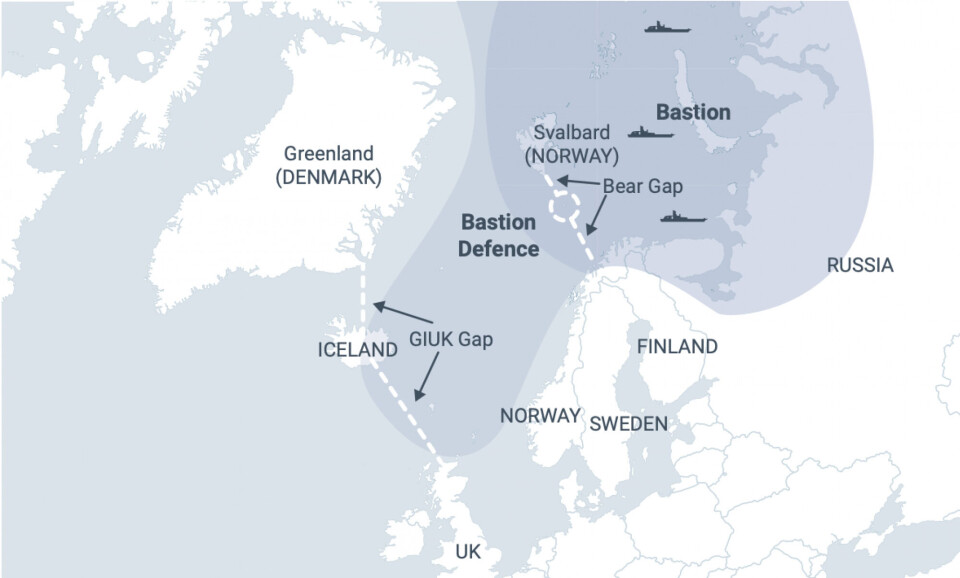
U.S navy submarines have for decades patrolled the waters of the Norwegian- and Barents Sea as part of the long-established cat-and-mouse game of submarine hunting. For NATO, it is of vital importance to keep track of Russia’s silent multi-purpose subs sailing out to the North-Atlantic with new long-range cruise missiles with high precision. To spend as much time as possible up north, the U.S. submarines frequently change crew members and get supplies in fjords outside Tromsø. Sailing south to any of the naval bases Haakonsvern in Bergen or Faslane in Scotland for the same job would add several days away from the sub’s main duty, following the Russians down deep up north.
The Barents Observer has previously reported about the increased presence of American submarines in Norwegian waters, in 2018 said to be inshore 3 to 4 times monthly. Also, to help keep track of the Russian subs, U.S. Navy P8A Poseidon Maritime surveillance aircraft are frequently, including this October and November, deployed to Andøya military airfield inside the Arctic Circle in Norway.
The over-land distance from Tromsø to the Russian border is more than 450 kilometers, but for the Northern Fleet based on the Kola Peninsula, the Norwegian Sea has increasingly been part of the playground when exercising the Bastion Defense concept. Powerful American assets would seriously challenge Russia’s capabilities to conduct sea-denial operations in the area in case of conflict.
Julie Wilhelmsen with the Norwegian Institute of International Affairs (NUPI) is an expert on Russian foreign and security policies. She says the intensity in Russian statements on Norwegian defense policy has escalated in recent years. “In particular since the 2018 Trident Juncture exercise.” Participating in the exercise was USS Harry S. Truman, the first time since the 1980ies an American nuclear-powered aircraft carrier sailed inside the Arctic Circle near the Lofoten archipelago.
“Russian criticism is raised with every new adjustment made to Norwegian defense policies aimed at strengthening allied presence in the north,” Wilhelmsen says. She sees Zakharova’s statements on U.S. subs in Tromsø as part of this pattern.
Russian criticism is raised with every new adjustment made to Norwegian defense policies.
“While Norway contends that these are small changes and that the Norwegian policy of balance between deterrence and reassurance are unchanged, Russia insists that the changes are threatening and in breach with former policies,” Julie Wilhelmsen explains.
“Russian rhetoric on Norway is part of a broader pattern found in general foreign policy discourse in recent years focusing aggressively on increasing US military installations and presence closer to Russia’s borders anywhere, in Georgia to the south or in the Far East,” she says.
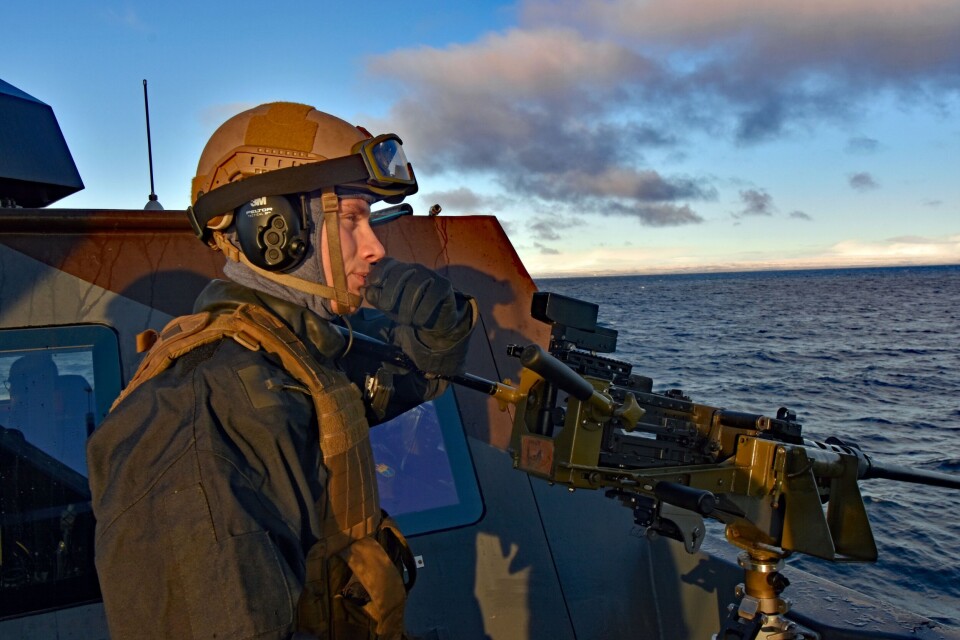
Cold Response
A new large-scale exercise is planned during winter months of 2022 in northern Norway.
Cold Response 22 is a Norwegian hosted exercise where allies and partners are invited to attend, says Brigadier Eystein Kvarving, spokesperson for the Chief of Defense. “It is a defensive exercise, and the aim is to train reinforcement of an allied/partner under challenging climatic conditions. Cold Response 22 will have more emphasis on the sea and air domains than Trident Juncture 18, which had a greater footprint on land,” Kvarving says.
He expects approximately 40,000 personnel from around 10 nations to attend. “Norway have already notified all member states of the Organization for Security and Cooperation in Europe of exercise Cold Response 22. Norway will, in accordance with the Vienna Document and to be open and transparent, invite all 56 signatory states to observe the exercise,” Eystein Kvarving tells.
Russia is one of the signatory states in OSCE.
Nuclear-bombers
In the skies above Scandinavia and outside Norway’s territorial borders, U.S. long-range nuclear-capable bombers have in the course of the last two years become frequent flyers. Often in sorties where Norwegian or Swedish fighter jets participate. Russian long-range nuclear bombers, like the Tu-160 and Tu-95, resumed patrols outside Norwegian and European air space in 2007.
Defense Minister Bakke-Jensen says increased NATO operations in the north are not a result of Norway’s own limited military forces after years of disarmament.
“We have asked NATO to focus much more on the north after a period when NATO’s focus has been in Afghanistan and other non-Western areas. NATO is back in home waters,” Bakke-Jensen says. The minister tells about the new command structure in Norfolk. “The U.S. 6th fleet sails more up north, and we are exercising more with our allies, that be Americans, British, Dutch or Germans.”
Political decision
Frank Bakke-Jensen makes clear it was a political decision to sail a frigate to the waters outside the Russian naval bases on the Kola Peninsula together with U.K. and U.S. navy ships in September this year.
“The decision whether to take part or not and how to balance our relations with allies and to our neighbor in the east is a political question. It was a political decision to participate,” the Defense Minister says.

He underlines that for Norway, and NATO allies, being transparent about its military activities is important and should help to build better relations with Russia.
Lack of transparency of Russian military activities in the north, from announcing exercises to the size of troops participating, is a major reason for concern in the west. Like in August 2019 when the movement of large naval forces from the announced Baltic Sea exercise Ocean Shield to the waters outside northern Norway came as a big surprise to the Norwegians. The objective of the exercise, as it turned out, was to block NATO’s access not only to the Baltic Sea but also to the North Sea and the Norwegian Sea. Such exercises are more sophisticated nowadays than previous Russian military drills and involve land forces, like the new Arctic brigade, air and naval forces in comprehensive joint operations. Less predictable military maneuvers, and hybrid-warfare strategies, cause headache to both Norwegian and NATO planners.
To build a military strategy based on uncertainty, complexity and rapid changes is somewhat difficult.
Professor Heier recommends a dual policy with continued deterrence within a NATO-framework and enhanced bilateral reassurance towards Russia.
“The deterrence dimension should emphasize allied presence in Norwegian areas, but further south in order to signal that Norway wants to give Russia’s Northern Fleet a longer strategic warning-time. The reassurance component should emphasize a more intensified effort to stir working-level dialogue and cooperation. This is particularly so along less ‘securitized’ policy-areas, such as environment, trade, fishery and Arctic research,” Tormod Heier says.
Civilian cooperation
In its new Arctic Policy white paper presented the last week of November, the Norwegian government outlines the dramatic shift in regional security. Norway’s relationship with the powerful eastern neighbor is completely altered, as “Russian build-up of forces and military modernization could directly challenge Norwegian and allied countries’ security, the paper reads.
At the same time, the strategy highlights civilian cooperation benefiting both countries. Norway and Russia continue to cooperate on issues such as fisheries, nuclear security and the environment, as well as in multilateral arenas like the Arctic Council and the Barents Cooperation.
Julie Wilhelmsen with NUPI stresses the importance of continued collaboration and contact with Russia on these practical issues as well as on the multilateral arenas of the Arctic and Barents region. Achieving reassurance can also be done indirectly by soft-security measures, she says.

“The government, in particular the Foreign Ministry, has been carefully attending to this aspect of relations with Russian in recent years as far as I can see. However, today the great-power rivalry and the escalating security dynamics ‘above’ Norway as a small state in between Russia and the USA seem to limit the effect of bi-lateral cooperation as a means of building confidence and reassurance,” Wilhelmsen says.
She recommends more regular diplomatic contact as a means of exchanging frank views, possibly also restart military-to-military contacts that were broken off after Moscow’s annexation of Crimea in 2014.
Military buildup
Meanwhile, Russian military buildup on the Kola Peninsula and in the Arctic continues in new and dramatic ways. Current constructions of nuclear-powered submarines have never been higher since the Cold War. New ballistic missile subs of the Borey class and multipurpose subs of the Yasen class are armed with weapons almost impossible to intercept by missile shields. New subs for special underwater operations are in pipe, and testings of the Poseidon torpedo-style nuclear-powered drone are underway. A nuclear-powered cruise missile, the Burevestnik, has already caused major concerns as a recovery accident in the White Sea last year showed the potential for spreading radiation over populated areas.
Major infrastructure new-buildings are underway at the naval bases of the Northern Fleet, and more than 50 reinforced large weapons bunkers are under construction in Okolnaya Bay and in Gadzhiyevo.
Hypersonic cruise missiles that could take out targets in most of Scandinavia within minutes are under testing from both surface warships and aircraft based near Murmansk.
Warning time for a potential limited or major conflict has shortened.
Arms treaties
Unlike during the 11th hour of the last Cold War, all this happens as arms control agreements are faltering and deteriorating.
- The United States withdrew from the 1972 Anti-Ballistic Missile (ABM) Treaty in 2002.
- Russia withdrew from the 1992 Treaty on Conventional Armed Forces in Europe (CFE) in 2015.
- The United States suspended the 1988 Intermediate-Range Nuclear Forces Treaty (INF) in February 2019, and Russia did so in response the following day.
- The United States withdrew from the 2002 Open Skies Treaty on November 22, 2020, while the 33 other party states, including Norway and Russia, continue.
The last treaty now in jeopardy is the most important of them all: The 2010 New Strategic Arms Reduction Treaty (New START) which limits the number of deployed missiles and bombers to 700 with a maximum of 1,550 deployed nuclear warheads on each side, in Russia and in the United States. The treaty expires on February 5, 2021, unless the two countries’ presidents agree otherwise.
If Russia and the United States fail to agree, there will no longer be any arms agreements limiting the numbers of nuclear weapons deployed on the Kola Peninsula or at other locations. Also, the current regime for joint inspections, verifying, transparency and trust-building will come to an end.
At the meeting with his top military brass this November, President Putin made clear: “Considering the military and political risks in today’s world, we will further upgrade our strategic nuclear forces and consistently strengthen all their components.”
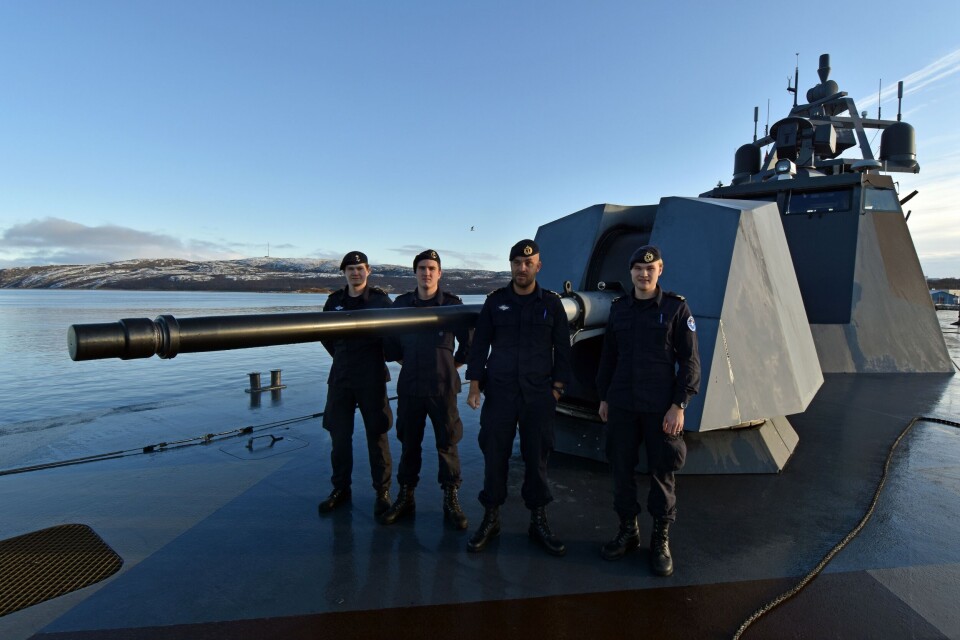
You can help us report more about the security situation up north…
…. we hope you enjoyed reading this article. Unlike many others, the Barents Observer has no paywall. We want to keep our journalism open to everyone, including our Russian readers. The Barents Observer is a journalist-owned independent newspaper. It takes a lot of hard work and money to produce. But, we strongly believe our bilingual reporting makes a difference in the north. We, therefore, got a small favor to ask; make a contribution to our work.
Fra Norge kan du gi et lite støttebeløp via Vipps: 105792
















